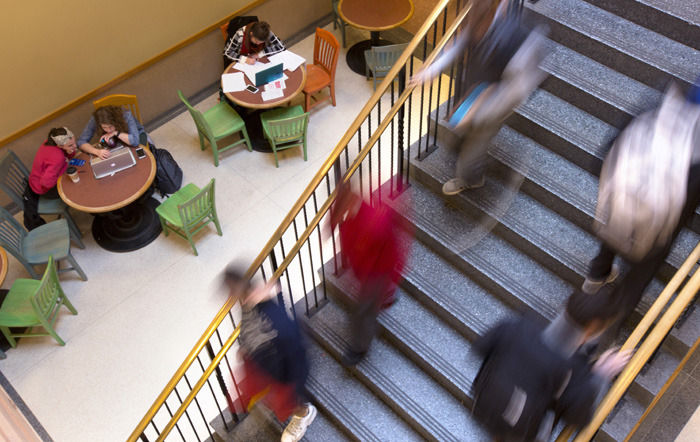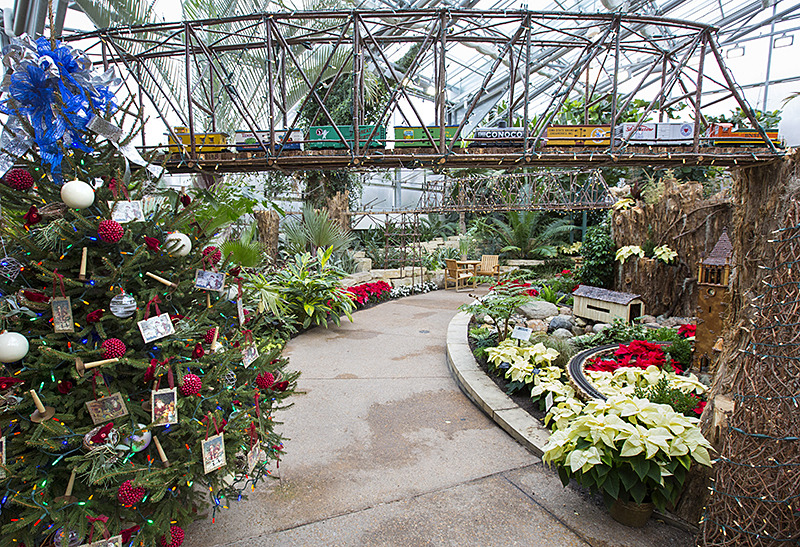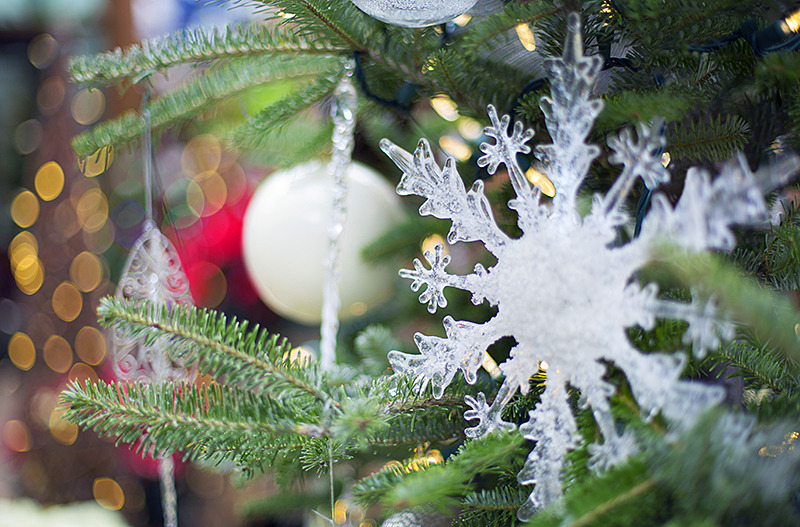Getting the job done

Some students study while others move toward their next finals week deadline inside the Union Drive Community Center Tuesday morning. Final exams wrap up Friday; commencement events begin Friday and continue into Saturday. Photo by Christopher Gannon.
A record number of students graduate this week
Nearly 2,000 Iowa State students who are completing degrees this semester will participate in graduation events this weekend. A single commencement ceremony begins at 1:30 p.m. Saturday, Dec. 19, in Hilton Coliseum. This is not a ticketed event.
Iowa State will award an estimated 111 doctoral degrees, 251 master's degrees and 1,631 bachelor's degrees this week, the most ever at the December commencement. In addition, some of the 748 Iowa State students who completed their degrees at the end of the summer term will participate in Saturday's commencement ceremony.
Honorary degrees
During the ceremony, Iowa State will award honorary doctoral degrees to alumna (economics, 1970) and economist DeAnne Julius and Iowa businessman Eugene Sukup.
Julius will receive a doctor of humane letters for her "many outstanding contributions and distinguished service in economics, business, international relations, government, policymaking and academia." Also a graduate of Ames High School, her career includes positions with the Central Intelligence Agency, World Bank, Bank of England and the think tank Chatham House (also known as Royal Institute of International Affairs), where she currently serves as senior adviser to its board. Julius will give the commencement address.
An honorary doctor of science degree will be presented to Sukup for his "contributions to state, national and global agricultural challenges," particularly in the area of grain storage. With his wife, Mary, Sukup founded Sukup Manufacturing in 1963 in Sheffield. Today, the company employs 550 people. Over the course of 50 years, he has received 40 U.S. patents and 10 foreign patents; the company holds another 44 patents. The Sukups have supported numerous academic and athletic projects at Iowa State.
Watch online
For those unable to attend commencement in person, the registrar's office will provide a live video stream beginning at 1:30 p.m. The video will be archived on the registrar's YouTube channel within a couple of days.
College events
The six undergraduate colleges will honor their graduates at separate events Friday or Saturday prior to the university ceremony. Additionally, all graduates and their families are invited to a reception at the ISU Alumni Center following the university ceremony, or approximately 4 p.m.
The registrar's office also sponsors these graduation-related social media options:
Winter break partial shutdown reminders
As has been the case in recent years, university administrators have authorized a partial shutdown for an 11-day stretch during Iowa State's winter break, beginning Dec. 24 through Jan. 3. This period includes:
- Three university holidays (Dec. 24, 25 and Jan. 1)
- Four regular work days (Dec. 28-Dec. 31)
- Two weekends (Dec. 26-27 and Jan. 2-3)
Employees who choose not to work on regular work days must use vacation time or take unpaid leave. The shutdown is optional; the university is not requiring departments to close. Units involved in critical services, maintenance and research will remain open. If you need to get into your building, bring your key or access card. University officials expect many ISU facilities will be closed and locked during the 11-day period, similar to holidays and weekends.
More info
- Iowa State's flexible hours program
- Winter break schedules
Batten down the hatches
The partial shutdown isn't mandatory but university officials encourage employees to take some time off while the students are away, which also helps conserve energy. Last year, Iowa State saved approximately $25,000 during the 10-day partial shutdown period.
Building supervisors should contact Wendy Kisch in facilities planning and management by noon on Dec. 21 to indicate if a building will be closed or to request a temperature setback.
Keep the following in mind when you leave for winter break to keep your office energy-efficient and safe.
- Shut down all computers, printers and other accessories. Leave your office computer on if you need remote access from home, but power off the monitor, printer, speakers, etc. A computer's sleep mode uses less energy than full power, but information technology services guidelines recommend shutting down computers completely to protect data. A machine may be left on during break if it's providing access to a critical application. If possible, plug computers and printers into a power strip and then shut off the power strip before you leave.
- Turn off and unplug copiers
- Shut off and unplug small appliances, like coffeepots and microwaves
- Unplug chargers for electronic devices
- Check faucets in restrooms and break rooms to make sure they are completely turned off and not dripping. If you notice a dripping faucet, contact the FPM Service Center, 294-5100.
- If you can manually adjust the thermostat in your office, turn it down to 65 degrees
- Close fume hood sashes completely or open them only minimally
- Shut down unnecessary climate-controlled plant growth chambers
- Shut down cooling water systems to eliminate potential flooding issues
- Remember to turn off your office lights and as much public lighting (hallways, restrooms, conference rooms) as possible
- Check windows to make sure they're tightly closed
Keep in touch
If your department is closing over break, discuss how to handle incoming phone calls. One option is to direct all departmental calls to one voicemail box to be checked periodically by designated employees during the break.
Employees also should change their personal voicemail and email messages. Consider stating the dates you'll be absent, and if you'll be checking your messages. If necessary, include an off-campus number where you can be reached. Also consider posting holiday hours on your department's website.
Bundle up
FPM crews will work reduced hours during the partial shutdown. Snow removal will be limited from Dec. 24 through Jan. 3, which means parking lots and secondary buildings may not be plowed by 8 a.m. FPM staff also will not plow lots or sweep sidewalks for less than 2 inches of snow outside of weekday business hours (Monday through Friday, 7 a.m. to 4 p.m.).
Strategic plan groups summarize early efforts
The run-up to semester break is a bit busier than usual for the 100-plus faculty, staff and students serving on assorted strategic planning committees.
After break, the subcommittees working on key components of Iowa State's next strategic plan have a little over a month to develop and submit final reports to the steering committee.
Keep comments coming
While subcommittee work is well under way, there's still plenty of time for the university community to have its say in the development of the plan that will guide Iowa State through June 30, 2022, said Steve Freeman, steering committee chair and University Professor of agriculture and biosystems engineering.
Many already have done so, offering suggestions at public forums in November and December and via feedback forms on the strategic plan website. More than 200 comments were submitted through the website over the past two weeks.
"We encourage individuals to continue sending comments and questions to subcommittees," Freeman said. "For those who want to follow the work of subcommittees more closely, approved meeting minutes are available on the strategic plan website."
The timeline calls for the steering committee to submit a draft of the new plan to President Steven Leath in early March. Public comments on the draft will be sought during the last half of spring semester. The new plan will go into effect July 1, 2016.
Subcommittee reports
The six subcommittees provided these summaries of their recent activities.
Student experience
Each committee member completed a SWOT (strengths, weaknesses, opportunities and threats) analysis to identify key issues related to the student experience. Initial items included persistence and graduation rates disaggregated by race and gender, student learning outcomes, facilitators and obstacles to student learning, and access and availability of support services.
Research profile
The subcommittee identified four activities essential for strong research at Iowa State and assigned small groups to flesh out details on how to:
- Develop more coordinated, proactive faculty hiring strategies across the university and enhance collaboration among existing faculty and new hires
- Grow research expenditures
- Recruit high-quality graduate students and postdoctoral fellows
- Develop and implement a plan to enhance ISU’s research infrastructure
Economic development and service to Iowans
The subcommittee received briefings on the activities of ISU's offices of economic development and industry relations, and extension and outreach. Committee discussions focused on state economic development and service needs, including business and technical assistance for existing companies, training and development for community leaders, collaborative research with the private sector, technology transfer and workforce development. The committee also stressed the importance of alerting Iowans to ISU's economic services and addressing the unique needs of underrepresented populations.
Campus environment
The committee reviewed a variety of documents related to campus climate. The committee will develop a shared definition for a safe, welcoming and inclusive environment and build a broad list of priorities intended to achieve that environment. The original list will be narrowed to a manageable group of ideas that will be fashioned into strategic priorities.
Infrastructure enablers
The committee continues to gather comments submitted through the strategic planning website. Members have been named to liaise with the other five subcommittees to learn how infrastructure can better support the work of the university community. Space -- as it pertains to use, efficiency, safety, staffing, studying, transit, parking, facilities and accessibility -- is emerging as a theme in early conversations; additional themes are likely.
Additional creative oppportunities
Individual committee members have read various documents related to the strategic plan, and shared their summaries. Through this document analysis, members have begun identifying common themes, opportunities, gaps or pinch points. Committee members also are engaging constituent groups to gather ideas and input. Future meetings will generate big-picture ideas that address the themes and opportunities that are identified.
Students served by learning communities grows 40 percent in five years
More than 70 percent of Iowa State's direct-from-high-school freshmen are participating in a learning community this fall, the 21st year of the program. Learning communities aim to help students new to Iowa State succeed academically, make connections on campus and stay in school.
This fall's freshman participation rate, 72 percent, mirrors last fall's. Over the last five years, freshman participation rates have hovered around 70 percent. For minority freshmen, the participation rate is even higher, at 75 percent.
Nearly all of the growth in the program from last fall to this – 296 students in all – is in transfer students and sophomores, populations that program director Doug Gruenewald identified for growth four years ago. The total number of learning community students this fall – first year, transfer and returning – is 5,973. Learning communities with noteworthy growth this year include a sophomore version of Women in Science and Engineering (WISE) and a community that targets transfer, sophomore and junior students who are undeclared engineering students.
Of the 81 learning communities offered this fall, 35 of them either have sections reserved for transfer students or are open to transfer students.
Gruenewald credits the learning community coordinators for that growth. "Transfer students can be a tougher group to sell on the benefits of a learning community," he said. "The coordinators have to figure out what their transfer students need."
The same could be said generally for Iowa State's learning communities program.
"The whole point is to tailor the learning community to a specific group of students," Gruenewald said. "This isn't a one-size-fits-all experience."
Any Iowa State learning community might include some of these components: one to three shared courses, career exploration, service learning or community service, and social activities. About 25 percent of the learning communities include a residence hall component.
A few examples
Even though the number of students served has grown about 40 percent in the last five years, the total number of learning communities offered hasn't strayed far from 80. Growing communities add sections, under-utilized ones are discontinued, new ones targeting a different student population are piloted. Gruenewald said the discipline-centered learning communities have the best chance for longevity. This year's eight new learning communities include:
- The Sky is the Limit, an interdisciplinary exploration of majors and careers for open-option students in the College of Liberal Arts and Sciences
- Future Teachers, Future Leaders, for transfer students in elementary education and current students changing their major to elementary education
- M-STEM, for multicultural transfer students in a STEM major
Among the largest learning communities:
- Animal science (336 members), for all freshman and transfer students in animal science, dairy science or general pre-veterinary medicine
- Women in Science and Engineering (379 members), for first-year female students majoring in one of about 50 science/engineering majors
Among the smaller learning communities:
- Entrepreneurship and Innovation (23 members), for students in any major looking to gain skills in small business management and leadership
- Writing Gender/Women's Studies (21 members), for students in any major taking English 250, also linked to women's studies 201; students analyze the intersection of gender, race, class, nationality and sexuality through written, oral and visual communication
Common threads
Regardless of size, Gruenewald said the common threads to all learning communities are coordinators who, in most cases, are academic advisers, and returning students who serve as peer mentors -- about 550 strong this year.
"Most mentors came from the learning community they're leading and they want to help other students. They are very effective at that," he said. "The more student-to-student contact, the better."
Nearly 100 employees serve as learning community coordinators, some for more than one learning community. Gruenewald said their efforts to make their learning communities successful are "exceptional."
One of the strengths of Iowa State's program is that learning community duties now are written into the coordinators' jobs.
"We've developed an infrastructure to sustain the program, regardless of staff changes," Gruenewald said.
Read this before going to campus during break
Call ahead or check websites before trekking to campus during winter break. Following is a list of closures and holiday schedules for popular campus facilities.
Prepare for break
Athletics ticket offices
Jacobson Building
Closed: Dec. 23-25, Dec. 28, Dec. 31-Jan. 1
Winter break hours: 1-5 p.m., Dec. 29-30, Jan. 2
Hilton Coliseum ticket office (southwest corner)
Open one hour prior to events: Dec. 30 (6 p.m.), Jan. 2 (1 p.m.)
Brunnier Art Museum (290 Scheman Building)
Closed: Dec. 20-Jan. 11
Christian Petersen Art Museum (1017 Morrill Hall)
Closed: Dec. 19-Jan. 10
Farm House Museum (central campus)
Closed: Dec. 19-Jan. 10
ISU Dining (cafés, dining centers and C-stores)
All facilities are closed Dec. 19-Jan. 3, except the MU Market & Café, which is open 8 a.m. to 4 p.m., Dec. 19. Limited locations are open Jan. 4-6. See winter break hours.
ISU Postal and Parcel
Operating 8 a.m. to 5 p.m. weekdays (except for university holidays). Service will continue to accessible buildings.
Lied Center/Beyer Hall/State Gym
Memorial Union
Parking ramp doors and north doors accessible during university holidays and winter break.
- Hotel Memorial Union, closed at 5 p.m., Dec. 23 through Dec. 25
- Maintenance Shop, closed through Jan. 10
- Workspace, closed Dec. 18 through Jan. 10
Reiman Gardens
Closed: Dec. 25 and Jan. 1
University Book Store (Memorial Union)
Closed: Dec. 24-27, Jan. 1-3
Winter break hours: 8 a.m.-5 p.m., Monday-Friday, beginning Dec. 21 through Jan. 8; 10 a.m.-5 p.m., Jan. 9; 10 a.m.-7 p.m., Jan. 10
University Library (all sites)
Closed: Dec. 19-20, Dec. 24-Jan. 3
Winter break hours: 7:30 a.m.-5 p.m., Monday-Friday
Holiday express

The popular G-scale train display in Reiman Gardens' Hughes Conservatory weaves its way through a nostalgic holiday backdrop, accented with hundreds of live poinsettias and flowering paperwhite plants. The "Treasures from the Attic" exhibit, which spills down the hallway leading to the conservatory, features previous holiday displays and decorations as part of the gardens' yearlong 20th anniversary celebration.
Reiman Gardens is open 9 a.m. to 4:30 p.m. daily, but will be closed Dec. 25 and Jan. 1. Admission is $8 for adults, $7 for seniors, $4 for youth, and free for members, ISU students and children ages 3 and younger. The exhibit runs through Jan. 10. Photo by Christopher Gannon.

